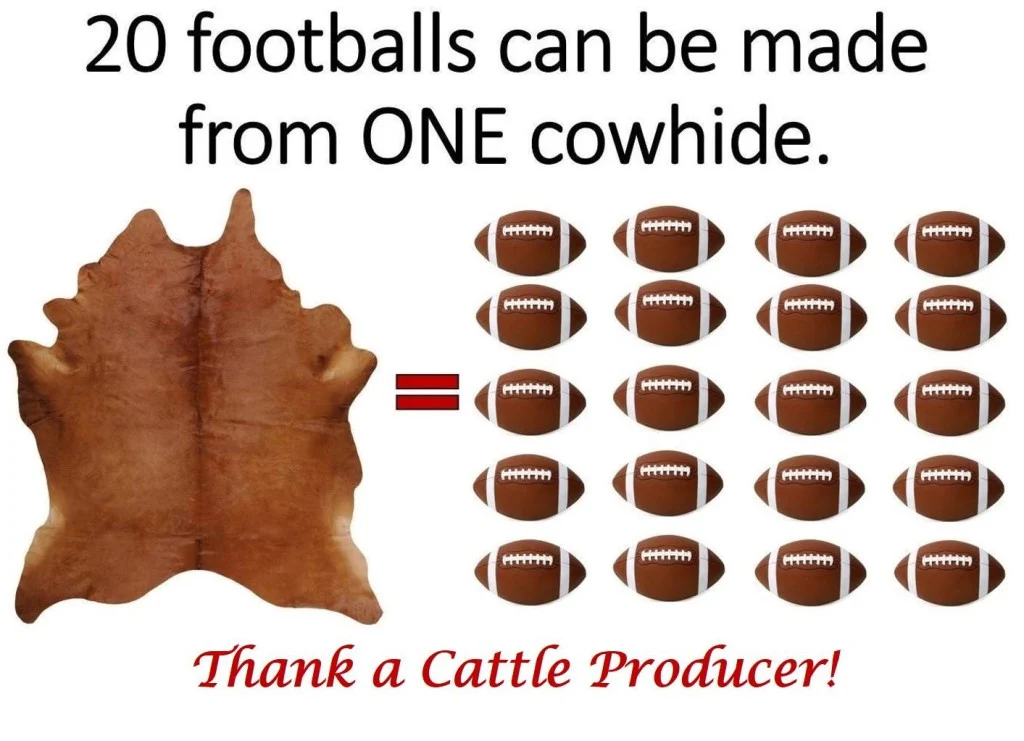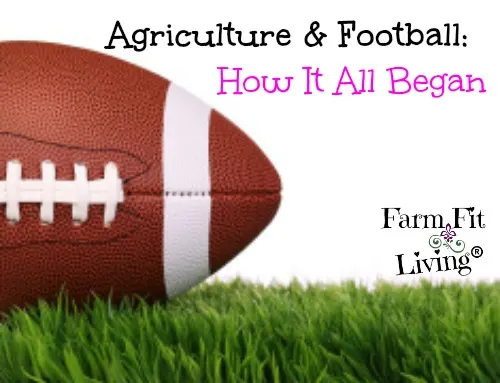You may be a football fan. But are you a fan of agriculture & football?
Well, agriculture (ag) made football. No bull. From the playing field to the yummy tailgate food and fun, ag has played an important role since the very beginning.
Types of agriculture used to make the game of football happen includes livestock production, crop production, veggie and fruits, turf production. Everyone celebrates in different ways and uses different products. But bottom line, agriculture examples in relation to the popular and loved game of football can vary in lots of different ways.
Bottom line is: Without ag, it would be hard to see the kind of football entertainment we know and love. Although some aspects of the game has gone to synthetic practices, ag has paved the way for America’s favorite fall sport.
I love football and I love agriculture. I love they are linked! Here’s the scoop on the beginnings and how the ag industry played a position throughout the game.
In this post, you’ll find:
- The true relationship between agriculture & football from the beginning to end.
- Information about how footballs are made, as well as other products grown by a farmer.
- How even the biggest football game depends on agriculture.
Lets jump right into the good stuff, discovering the legacy of agriculture & football.
Disclosure: This post contains affiliate links. There are links within this post on which I can earn a commission if you purchase something, but at no additional cost to you. This is how I can continue to post high quality content for your enjoyment.
Food & Drink
My favorite part of the football game is tailgating. If you haven’t experienced a football tailgate, you’re missing out. It’s a tradition in these parts that keeps on keepin’ on.
Tailgating is this: Food, drink and socializing is a popular norm before, during and after the big game. Families and friends gather together and enjoy a delicious colorful spread laid out on the tailgate of a vehicle.
And at my family tailgate, ingredients grown on farms across the country are used to prepare the food and drink at tailgates. Crock pots, portable grills, and coolers are used to transport food to the parking lots to enjoy during the tailgate. No matter what is enjoyed, the food and drink consumed at the tailgate was grown by a farmer.
My favorite item to have at tailgates is this Coleman portable grill. Get yours here
In fact, here are the top foods consumed on game day:
- Chicken Wings (1.33 Billion according to the National Chicken Council)
- Pizza (11 Million Slices according to Domino’s) – Read How Farmers Grow A Pizza
- Popcorn (8 Million Pounds)
- Potato Chips (28 Million Pounds made from potatoes)
- Avacados – 104.9 Million Pounds according to the Hass Avacado Board. (Guacomole, anyone?)
- Beverages: According to Nielsen, $1.2 billion will be spent on beer (made from hops), flavored malt beverages and cider; $594 million on wine (made from grapes); and $503 million on whiskey (made from corn), vodka, rum, tequila and gin. (Don’t drink and drive, please!)
My favorite tailgate meal is chili on a cool day or a delicious egg breakfast on a brisk morning. We also love chicken wings from our own home processed chickens.
For information about Processing and Freezing Chickens, Go Here
For my Scrambled Egg Recipe, Go Here
Another interesting tid bit is that Super Bowl Celebrations bring in the 2nd most calories behind Thanksgiving Day. Now, let’s toss a little “pig skin” with your favorite people.
Here’s more tips for burning excess calories on holidays and at parties
The Game Ball
Have you ever heard a football be referred to as a “pig skin?” You see, early footballs were made from pig bladders.
After the pigs were harvested for meat, the bladders were inflated into a small ball.
Heaps of fun for folks of all ages.
Laura Ingalls Wilder actually discusses this fun activity in her book, Little House in the Big Woods. This story also gave footballs the nickname of “pig skin”.
For More Rural Life stories written by Laura Ingalls Wilder, Check out her Series Here
All fun and games, but pig bladders aren’t really the primary materials to make a football anymore. Now, it’s about the beef. Well, at least the skin of the beef.
 Nowadays, most footballs used for competitive sport are made from cowhides. According to Beef Check-off, 20 footballs can be made from just one hide.
Nowadays, most footballs used for competitive sport are made from cowhides. According to Beef Check-off, 20 footballs can be made from just one hide.
That is pretty efficient. And one of the top goals or branches of agriculture is to maximize efficiency. So, you can understand why beef hides started being used to make this American game ball.
Who Makes the Game Ball?
The only football manufacturer the NFL allows to make their game balls is Wilson Labs. All footballs are created by hand by 120 employees.
These hardworking folks produce 4,000 footballs daily for us to play with. Wondering how they do it?
How Are Footballs Made Step by Step?
Well, here’s a handy video of how football is made by Wilson out of cowhides for big games.
Watch How a Football is Made step by step over at Wilson Company HERE
Get Your Own Wilson Football Here
Ag still plays a major role in producing game balls and the refreshments for our celebration of football. But some changes have been made to other realms of the sport, cutting ag products out of the picture. Let’s explore how football materials and equipment made by agricultural products have changed over time.
Football Uniform Changes
In the early days, the jerseys were heavy. The jerseys were woven using wool from sheep. Shoes were bulkier, made of leather or wood. Socks were made from wool and cotton.
All agriculture products grown around the country were used to make the original uniforms worn by football players. Over time, changes have been made to make football uniforms, socks, shoes and protective equipment lighter and more usable.
Today, the majority of football jerseys are now made of different forms of synthetic polyester. Not really an agricultural product grown, synthetic polyester is made from chemical synthesis.
Here’s another realm of the football world currently using chemical synthetic fibers.
Changes to the Playing Field
My high school football field back home still uses a grass field that is watered and babied daily by the football coach and his family.
Talk about dedication! And you’d know it if you saw it because it is perfectly mowed, bright green and beautiful.
Grass fields have always been the norm in the football world. But it takes a lot of work to make these fields look nice. The fields are watered and mowed regularly to keep the grass green and neat. Some fields are also fertilized in the spring or fall to keep the grass growing green.
To find out how real turf is grown by a farmer for the San Francisco 49’ers Field, Watch Here
Also, knowing the type of grass and how to care for it is an important skill for field managers to learn. It is quite a bit of work to care for a football field of any size.
Because of all the work and dedication it takes to maintain a proper football field, most college and professional fields and even some high school fields have changed to synthetic turf.
Synthetic turf does not need to be mowed or watered. This makes the care and input costs lower for the team budget. Remember that word…”efficiency.” Some teams don’t have anyone willing to make or take the time to care for a real field.
So, that is the main reason for synthetic turf. Time management and making priorities happen. It’s all about finding balance.
BUT Agriculture is Still MVP
It’s true that some of the football world has turned to synthetic fibers for various reasons. The three main reasons for this turn has been convenience, usability and cost.
In fact, a lot has changed since the beginning of the game. But, there still wouldn’t be football without agriculture. Agriculture is the original MVP, starting the trends that make the game of football what it is today.
As you watch the big game sipping your strong one or tossing that pig skin (or is it cow skin?)…remember how that product was made. Remember that a farmer worked long hours to feed and care for that animal or crop that was later used to make the products we couldn’t live without today.
And may your team win the big game.
[[clickToTweet tweet=”‘Agriculture paved the way for the game of football.” quote=”Agriculture paved the way for the game of football.” theme=”style1″] “]
~ Much Love ~





7 Healthy Holiday Tips for Families | Farm Fit Living
Wednesday 13th of December 2017
[…] going outdoors and enjoying the fresh air will really help your immune system thrive. Get a game of football or hide and seek going with the kids. This helps everyone to get exercise as […]
7 Calorie Burning Activities for Fall | Farm Fit Living
Monday 16th of October 2017
[…] would not be Fall without Football Games! Whether it’s Little League, High School or College, the pigskin is just a part of […]